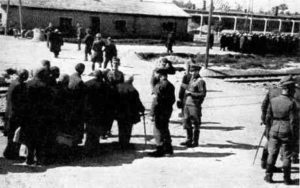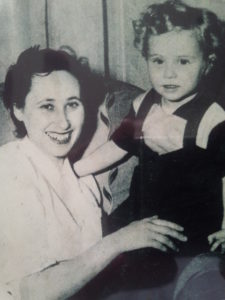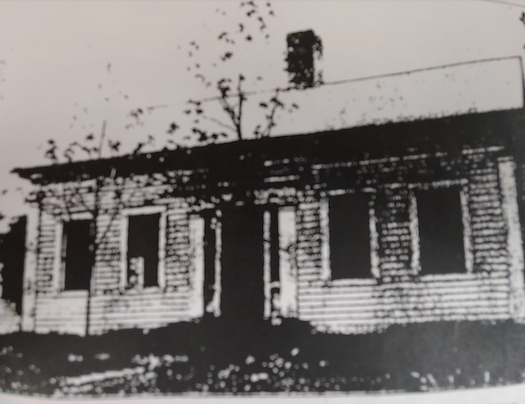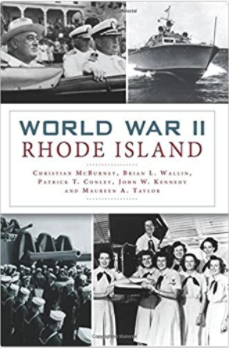When I was about fourteen years old, sifting through the world history section at the Kingston Free Library, I came across a book by Judith Sternberg Newman, who then resided in nearby Richmond. It was her memoir about surviving Auschwitz, the biggest and most monstrous of all the Nazi death camps in World War II. I could not believe that the book, with its horrific photographs of concentration camp victims and numerous detailed accounts of atrocities, would be made available to a young teenager like me. I read the book before anyone realized the mistake. The book made a deep impression on me: it made realize that good and evil existed in the world and about the importance of promoting tolerance of people from different backgrounds, races and religions.
From 1947 to 2008, Judith Sternberg Newman resided in Rhode Island. For most of those years, since 1961, she lived on a farm in Richmond with her husband, Senek Newman, a labor camp survivor, where they raised four children. She and her family lived a good life in Richmond. Senek died in 1985 and Judith passed away in 2008 at the age of 88.
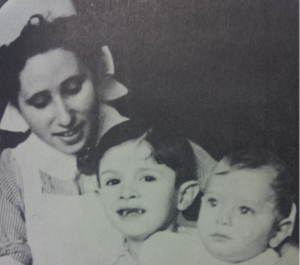
Judith Sternberg Newman as a young nurse in Breslau prior to her time at Auschwitz (Newman, In the Hell of Auschwitz)
As I look back on Judith’s life, I wonder how, after experiencing perhaps the most horrific man-made conditions the world has ever seen, she could have recovered, lived a normal life, and raised a loving family? While she was one of the few who survived Auschwitz, her entire family and fiancé perished in the Holocaust, except for her father who died in 1937. She saw hundreds of others die before her eyes, and thousands marching to the gas chambers.
Judith and her family hailed from Breslau, Germany. In 1937, the Gestapo forcibly removed her father from his variety store and he died of a heart attack shortly thereafter. Her mother lost the family house the next year so family members were dispersed around the city. Making the best of a worsening situation, Judith began her career as a registered pediatric nurse in the local hospital. She became engaged to Martin Tallert, a budding lawyer. On February 23, 1942, the Gestapo came again, this time rounding up thousands of Breslau’s Jews and forcing them onto crammed cattle trains bound for Auschwitz. The unknowing victims packed what belongings they could carry with them and went on the dreadful one-way journey.
Taken in her nurse’s uniform, Judith was just 23 years old. She travelled on the train with her mother, her younger sister Herta, 21, and her brothers Salli, 28, Siegfried, 21, and Arthur, 19. They and the others arrived at one of the most inhumane places the world has ever known: the Auschwitz concentration camp in Poland. By early 1942, it had become an assembly line of death where more than 1 million would perish at the hands of the Third Reich. About 865,000 were killed as soon as they arrived with up to 6,000 being gassed in a single day. The vast majority of the victims were the Jews of Europe, subjected to Adolf Hitler’s “Final Solution.” But others who were deemed not to conform to the racial and ideological standards of the Nazis also died: ethnic Roma. gays. Jehovah’s Witnesses, and Polish and Soviet prisoners of war.
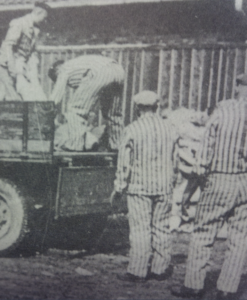
Rare photograph of Auschwitz, circa 1944. Camp inmates remove dead victims from a truck (the left side of the photograph has been cropped to delete piles of dead bodies) (Newman, In the Hell of Auschwitz)
Auschwitz was not a single camp, but was really a vast, sprawling network of extermination and slave labor camps. The gas chambers and the five crematories were operated day and night. Fortunately for Judith, she was a nurse who could help to treat sick laborers so that they could return to their tasks cutting timber, carting away the dead, and doing other camp jobs.
One by one, Judith heard of her family members being murdered or dying. Her fiancé died of typhoid fever. Herta survived until April 1942, when an SS guard pushed her over the lip of a stone quarry. Her body was taken back to camp and cremated. From a woman worker in the records office Judith learned that her mother and brother Arthur had been gassed on March 5, 1943. Salli, her oldest brother, went to the gas chamber in January, 1944, 22-year old Siegfried in August.
Judith survived, but what she witnessed no human should ever have to see. Here are just a few of the many gruesome excerpts from her memoir.
- “It was very cold, and it was raining. Some of the patients died before they even reached the gas chambers. Many of them were covered all over with excrement, for there were no sanitary facilities, and they could not keep themselves clean because of diarrhea. Some were holding on to their last piece of bread, which was worth more in camp than gold or diamonds in the outside world. Naked, their last piece of bread in their hands, they were driven toward the crematory.”
- “If a patient died during the night, then the rats, which abounded everywhere, would get at the body before it was cold, and eat the flesh in such a way that it was unrecognizable before morning.”
- “Today, we had to bring in eight or ten bodies of girls who didn’t die from weakness during the day, but who were beaten to death by the troop leader and the female guards.”
- “I had lost all desire to live. I said to [my sister Herta], ‘Let’s go to the gas chambers together; we’ll never get out of this hell alive.’ But she implored me, ‘No, no. Have courage. We still want to live. We do believe in God, and perhaps He will send a miracle.’”
Judith’s book makes for tough reading. One must take frequent breaks to get through it.
Once the camp guards gathered all of the hospital workers and patients and sent them off to the gas chambers, perhaps not wanting any surviving witnesses. Fortunately for Judith, she was out on a mission at the time.
After three years, the tide of war on the Eastern Front turned against the Germans and the Russian army began closing in. German camp commanders decided to march the surviving prisoners towards Germany. Any prisoner who stopped to rest during the exhausting march was immediately shot. Judith survived many marches and bombing raids, but hunger, cold and rheumatism weakened her, placing her at risk. She decided to escape with another female prisoner. Miraculously, they were able to sneak away from the column in a town in what became East Germany. “I knew in my heart,” Judith would later say, “that we were going to have luck.” And they did.
The two women, still in prison clothes, decided to make their way towards the Russian army. On the way, some German citizens gave them food. Upon reaching Russian lines, a Russian officer, learning of their suffering during the past three years, gave them food and shelter. It was May 1945; Judith had survived the war.
Soon Judith sought to escape the dreary Russian zone, where ordinary Russian soldiers were raping many of the women they came across. Judith returned to Breslau, but learned that out of the 10,000 Jews who lived there prior to the war, she was one of just thirty-eight survivors. Judith made the bold but smart decision to travel to American-occupied Germany.
Judith went to work as a nurse in a camp run by the United Nations Relief and Rehabilitation Administration (UNRRA). That is where she met Senek Newman, whose father had been a businessman in Poland. He had worked at a brutal labor camp during the war and was the sole survivor of a large German Jewish family. The two married.
In America, President Harry Truman issued an executive order providing for existing immigration quotas to be reserved for displaced persons, which about 15,000 Jews relied on to immigrate to the United States in 1946 and 1947. American Jewish groups organized to bring some of the Holocaust survivors to the U.S.. A Jewish organization in Rhode Island volunteered to sponsor a handful of immigrants, including Judith and Senek, who arrived in Providence in June 1947. At the time, Judith was pregnant with her first child, Edward.
Senek at once began to work three jobs in Rhode Island, and Judith found employment as a nurse. They rented a second-floor apartment at 48 Halsey Street in Cranston. The newly-married couple began to build a new life in Rhode Island.
Judith sought to deal with her past. She decided she did not want her experiences and those of others at Auschwitz to be forgotten. She wanted the world to know. She began to write her memoir in the 1950s. Her son Edward recalled her typing it on a German typewriter. Then her transcript was translated into English and her book was published in 1963. Judith was rightfully proud of her book. Judith would later become fluent in English.
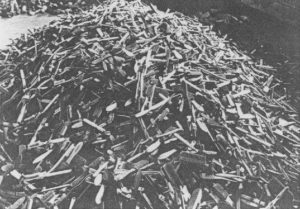
Hairbrushes of victims, found soon after the liberation of Auschwitz after January 27, 1945 (www.ushmm.org)
While Judith wanted the world not to forget the victims of the Holocaust, she and Senek never spoke of their wartime experiences with their children, even as the children grew to be adults. They did not want their children to suffer their pain. One time, when Edward was about nine years old, he was with his parents at a gathering of Holocaust survivors. A man began to speak Yiddish to Senek, which Edward understood somewhat (though his parents did not know that). The man mentioned that one of Senek’s brothers had been hanged at a German labor camp for stealing a piece of bread. It was the first time Senek had heard of his brother’s fate. Edward saw tears on his father’s face and understood why.
In 1961, the Newmans achieved their dream, purchasing a poultry farm in rural Richmond in South County. Senek turned the farm into a neat and productive enterprise. He eventually would become active in local politics and served on the Richmond School Committee that guided the construction of the Richmond Elementary School addition that was completed in 1968. At their farm, Judith was able to begin to put her past behind her and raise four children, Eddie, Stephen, Ronnie and Sharon.
“She loved living on a farm, it brought her peace and tranquility,” her adult son Ron informed an interviewer. “It was the place where my parents could call home again.” “Here now, I have peace. I can talk to God,” Judith told a reporter, motioning to the beautiful scenery that surrounded her at her farm.
Living on the farm, Judith developed a special relationship with the wildlife all around her. She loved all animals, especially dogs. Her black German shepherd, Wilbur, was a constant shadow, following her everywhere she went.
Her ability to find serenity was astonishing. She ended her book as follows. “We now live happily in a small town where my husband and I bought a farm. We deeply enjoy the peace and beauty of the woods, listening to the singing of the birds, and watching the deer when they come to drink in the river. At night I sometimes look up to the starry heavens, and it seems that even on the darkest night, the evening star shines brightly over our house, as if to remind us that God is with us always. We love this wonderful country and its people … God bless America.”
Judith treasured most her children and, eventually, her grandchildren. “We are very, very happy,” she wrote, “and I cannot help but feel that with each new life born into our family, one of our former loved ones has returned.” As her children grew to be adults, their mother never wanted any of them to leave the farm. Edward, a family court magistrate in Providence for many years, did leave. But Ronald, a former president of the Richmond Town Council and current member, and Sharon, a schoolteacher, built houses next door. Her son Stephen continues to operate Newman’s Egg Farm off Route 138 and will sell eggs to customers who stop in at the farm (and his mother’s book too).
Judith began to process her past. She once told a reporter, “That was the worst any human being has done. . . . I cannot forget it . . . . That made me believe there is no God . . . . A lot of [survivors] get crazy.” She continued, “Over here, I feel safe. I live with God. All my people who died—the spirit stays with me.”
Judith was remarkably forgiving and not bitter. She did not blame all Germans, only the evil ones. “The devil was living here on this Earth,” she said. “I’ve met him. I don’t think I have to go to hell no more. I have seen the devil.”
Love was a key coping mechanism. Ron Newman later recalled his mother’s firm advice, “Always tell the people you love, ‘I love you.’” “Not just once,” he said. “But all the time, whenever you are with family and friends. Out loud.” “My mother was a very loving and giving person,” Newman continued. “My mother taught us to enjoy life, to laugh, and in order to laugh, you had to be able to laugh at yourself.”
Judith frequently spoke to students at local schools, sharing and personally testifying to the horrors she faced. Judith would pull up the left sleeve of her dress and show students the concentration camp tattoo rippling down her arm below the elbow. The number 37909 and a triangle. “My sister had the next number,” she said. “She did not make it. We were just a number. We were not human beings anymore. We were just numbers.”
This is how Judith coped with the memories that haunted her most every day: not forgetting her experiences and sharing them with the outside world, but not sharing her experiences with her children; creating a life on an idyllic farm and getting close to nature; nurturing a loving family; and staying optimistic about the possibilities of life.
Even in her later years, while manning the Newman Egg Farm stand in Richmond, Judith would sit down with visiting strangers, sell them a signed copy of her book, show them her tattoo, and give a short lesson on the Holocaust. She could look back and justifiably be proud that she had successfully made the transition to a normal life and had raised a loving and successful family.
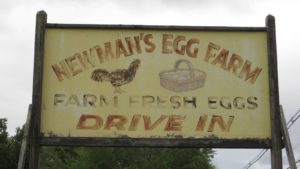
This outdoor sign for Newman’s Egg Farm on Route 138 has been a landmark for decades (Taylor McBurney)
[Banner Image: Judith Sternberg Newman as a young nurse in Breslau prior to her time at Auschwitz (Newman, In the Hell of Auschwitz)]
Bibliography
Judith Sternberg Newman. In the Hell of Auschwitz, The Wartime Memoirs of Judith Sternberg Newman. New York, NY: Exposition Press, 1963.
Alan Rosenberg, “Mere Words Don’t Do Her Justice,” Providence Journal, Feb. 6, 2008. Files of the Rhode Island Jewish Historical Association.
Richard Asinof, “Auschwitz Survivor Judith Sternberg Newman, 88, Dies,” Jewish Voice & Herald, Feb. 8, 2008. Files of the Rhode Island Jewish Historical Association.
Anne S. Davidson, “The Eleventh Hour, Survivor Finds Peace in Rural R.I.,” Jewish Voice & Herald, Aug. 20, 1992. Files of the Rhode Island Jewish Historical Association.
Robert L. Wheeler. “The Story of the Tattooed Nurse. After a long nightmare, it’s strictly morning-time for Judith Newman in her home on Halsey Street.” Providence Journal Sunday Journal, May 28, 1950. Files of Edward Newman.
“United States Policy Toward Jewish Refugees, 1941-1952,” in the online Holocaust Encyclopedia, at www.ushmm.org (search for Jewish Refugees 1941-1952).
The author thanks Judge Edward Newman for the privilege of being able to interview him. He has been appointed President of The Sandra Bornstein Holocaust Educational Center located in Providence (go to www.hercri.org). The author also thanks the Rhode Island Jewish Historical Association for providing me with its files on Judith Sternberg Newman.



